
Can you tell Anne is loving riding in the Faroes?
Although we are fair weather people, there is something about misty weather that somehow connects you more to nature. Even though the lighting is mostly grey, the greens look as if you are seeing them through polarising glasses. Yellow, pink, white, orange and purple wildflowers line the roads, walking paths and cover most pastures. It is not only the greens that are mindblowingly bright, every colour is sharp – the air must be so pure here. The beauty of riding bikes as opposed to driving is that you can smell nature, there are so many flowers, you can smell them as you ride. Maybe not so good for those with pollen allergy. You can also smell the fish as you ride through villages.
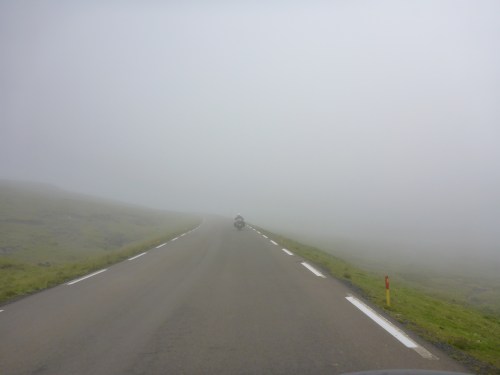
Foggy morning in the Faroes
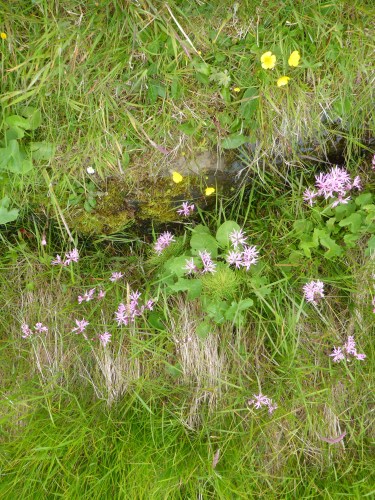
Wildflowers everywhere in the Faroes
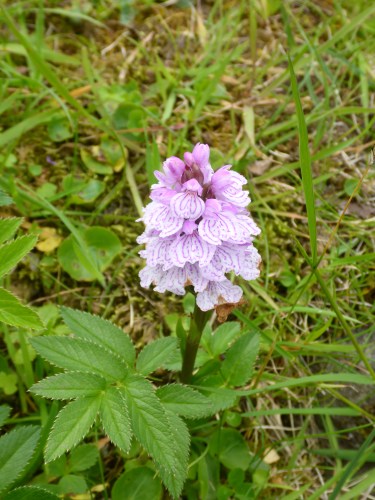
Wildflower in Tjornuvik, Streymoy

In Sandavágur, Vagar
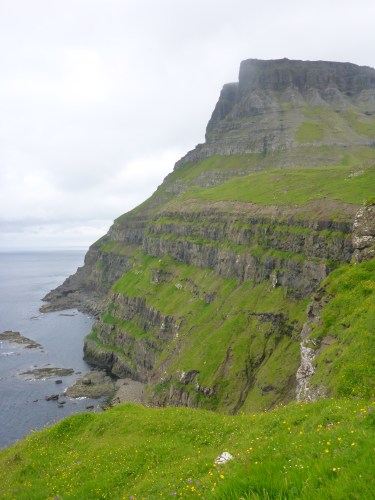
Gásadalur, Vagar
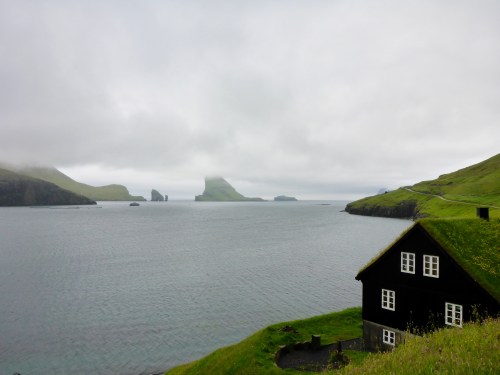
View from Vagar
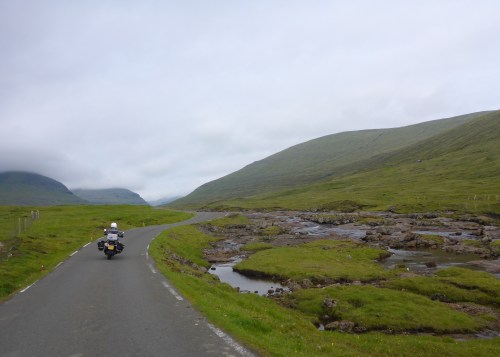
Up to Saksun, Streymoy

Typical church in the Faroes
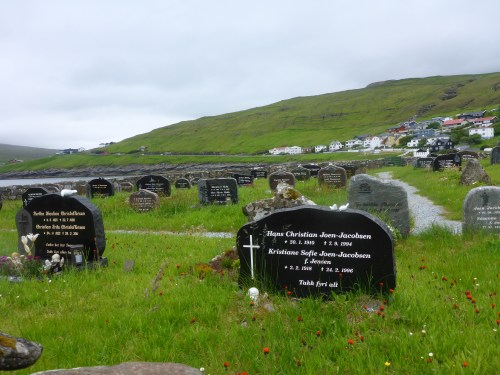
“Thanks for Everything” is commonly written on gravestones in the Faroes
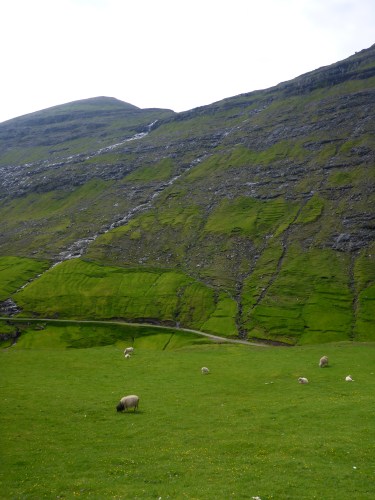
Saksun, Streymoy

Saksun, Streymoy

Saksun, Streymoy

On the way to Tjornuvik, Streymoy

Tjornuvik, Streymoy
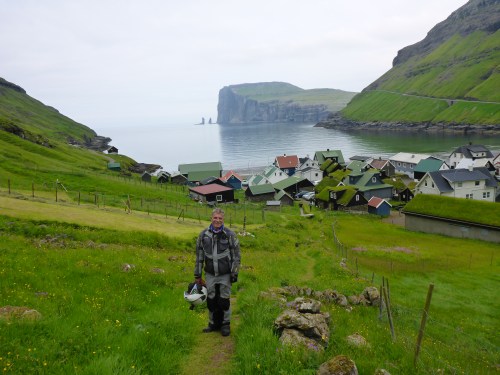
Tjornuvik, Streymoy
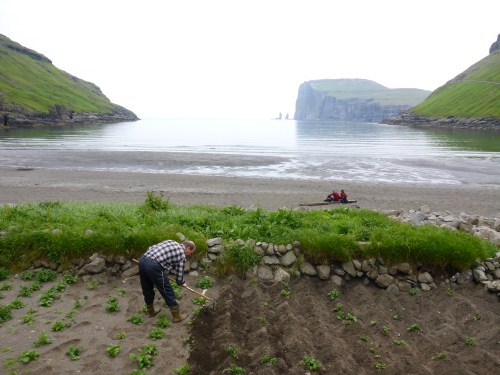
Planting potatoes in Tjornuvik, Streymoy

Waterfalls everywhere in the Faroes, Streymoy
The scenery is breathtaking! At times, it reminds us of either New Zealand, the Drakensberg in South Africa, Ireland or even Iceland. But the Faroes have a feel of their own. You feel the Faroese culture at every bend as the countryside is dotted with tiny hamlets, each costal one with its own little harbour. The air is clear like I have never experienced – even my own photos nearly look fake or like miniature villages.

On our way to Gjogv Eysturoy

Funningur, Eysturoy
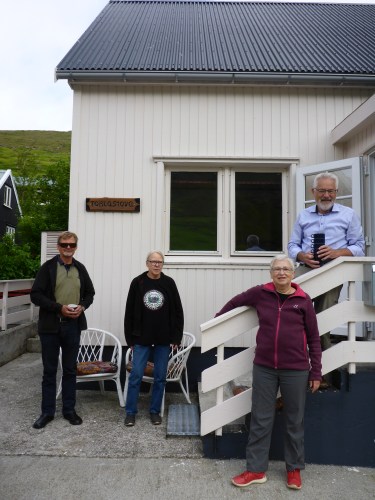
Bumping into Nimbus Danes we met on the ferry over in Funningur, Eysturoy
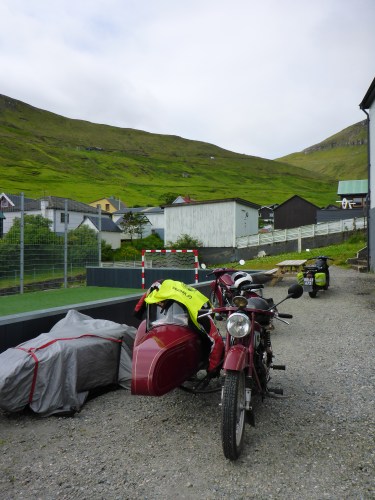
Some of the Nimbus bikes in Funningur, Eysturoy

Anne is happy in Funningur, Eysturoy
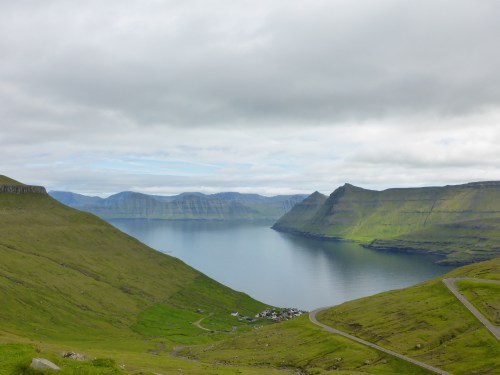
View from above Funningur, Eysturoy
We have visited a handful of the 18 islands which form the Faroes, enjoyed a number of small walks – it is hard to go for long hikes in motorcycle riding boots – and enjoyed just being, taking in the breathtaking raw beauty of this land. We were too late in organising ourselves for this trip to get to Mykines, one of the islands I really wanted to visit but had also been warned that trips there could be cancelled because of the weather – in our case, we could get there but not get back as every ferry and helicopter flight was fully booked. We didn’t want to take the risk of getting there and being stuck there for days. The attraction there was puffins and more inevitable breathtaking views. But we saw puffins elsewhere, in Gjogv (pronounced “jegv”) so all’s good.

Old port in Gjogv, Eysteroy

Gjogv, Eysturoy

Puffin spotting in Gjogv Eysturoy
And maybe there was another reason we had to go to Gjogv: as we were leaving the village, we bumped into a Dutch motorcyclist who was in Mongolia at the same time as us in 2017 and had been trying for the past 2 years to trace an Italian who he had heard had broken his ankle and had to leave his motorcycle behind to be shipped back. Feeling sorry for him, the Dutchman fixed the Italian’s broken windscreen for him and left a note wishing him well. He is Lino, the Italian we had come across in Khovd and for whom I had organised a local driver to take him to hospital. That evening, after returning to the campsite from Gjogv, I was able to email the Dutchman the Italian’s contact details. What are the odds, once again?!?! This really is such a small world…
The weather hasn’t been too bad. Apart from the first days when the rain was pretty heavy, we have just had a spattering of rain, and fog. No wind and not that cold. Making camping pretty enjoyable, even for Anthony! Sadly, the Faroes no longer allow wild camping because of too many inconsiderate tourists in the past so we have had to stay in official camping areas – nearly unheard of with the Speeds!! But we did find Aduvik, on Esturoy, which we ended up staying 4 nights because we loved the spot so much – can you tell?! Just a pity some people can be so noisy especially when in such a wonderfully quiet and wild area.
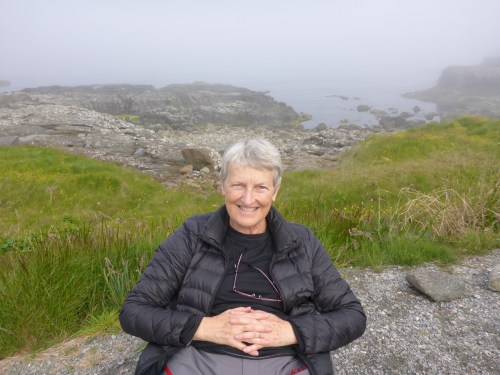
Camping at Aeduvik, Eysturoy
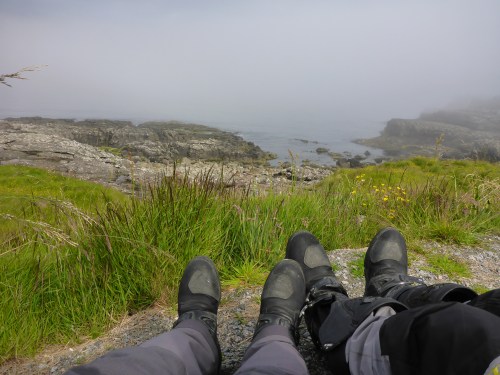
Relaxing at our camp at Aeduvik, Eysturoy

Watch where you’re walking when so close to the water – I tripped up taking photos of the algae!
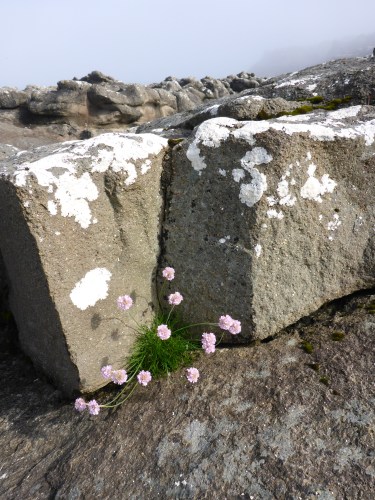
Exploring the rocks at Aeduvik, Eysturoy

Our campsite at Aeduvik
Travelling isn’t just about enjoying new scenery or riding fabulous roads, but all about the people and learning about new cultures. Talking to locals always brings an added level of appreciation of the places we are passing through. And what an unexpected and amazing evening last night!
As I stood looking out over the rocks, out to sea, I struck up a conversation with this guy who seemed to enjoy the area as much as I did. It turns out Jørgin is a local, and he and his wife and family are over to prepare the hay for his 88 year old father-in-law’s beloved 8 sheep, which Jacob keeps as a hobby but the whole family gets involved in looking after. Jørgin‘s wife Unn came over and we chatted for a while, until it was time for Jørgin and Unn to return to the field and get back to work. Jokingly, Unn suggested we go over and help to which Anthony suggested they could actually charge tourists to help them.
Well, I decided to go over and see what the process entailed and offered to help. They still follow the traditional Faroese process: after the grass is cut, it is first raked into little piles. Then you go back to each pile, turn the pile over, moving it away from it’s spot to allow the ground to dry, then spreading the pile flat again to allow it to dry. Because the weather was too damp, it was eventually decided to stop the spreading step and go to the next step of moving each pile into a single line down the hill. The next step involves pushing the central pile with the rake upside down, and pushing the grass into one massive pile which is then lifted into a large bale bag in a couple of easy swinging movements – that is best done by 2 people, each holding one bale bag handle, one foot standing on the edge of the bag and then scoop-rolling the hay into the bag. An hour and a half flew by. Because the hay and weather were too damp, the hay was then transferred to a drying ‘shed’ beside the campground. An old 1960’s car engine is used to heat the hay for 24 hours.
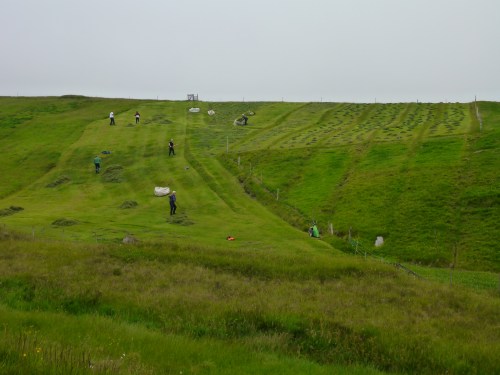
Preparing hay in the Faroes

Unn teaching me

Turning over and spreading the small piles to dry them out
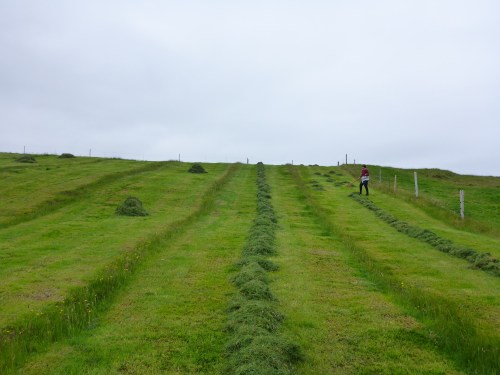
My line ready to be pushed down the hill
I hadn’t planned on spending an hour and a half raking grass and gathering it into bales. It felt great and I loved how it was a whole family affair, with 3 generations involved. Earlier, while we were raking, Unn asked me what we had planned for dinner: ham and crackers. Why don’t you come over to my parents for dinner and experience a Faroese home and dinner? What a fabulous offer? I accepted without asking Anthony as I knew he’d love the opportunity too.
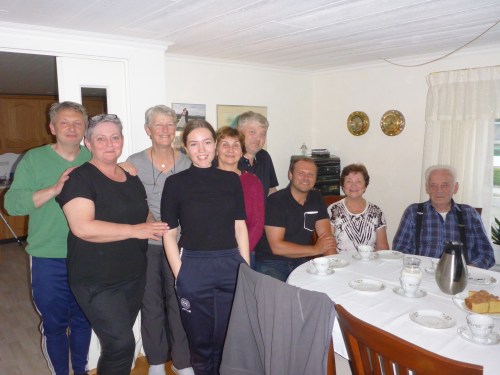
Jørgin and Unn on the far left
Not only did we have a sumptuous dinner of home made leek soup with meat balls, carrots and potato dumplings, home dried sheep, cod which Jacob caught earlier today (at 88, he still goes out fishing on his own every day), various cooked meats, cabbage salad followed by all sorts of chocolates and cake. We learned so much about life in the Faroes, including social security, employment insurance, retirement, higher education.
After dinner, Jørgin drove us to the largest fish farming company in the Faroes. They work 2 shifts a day so at 10:30 at night, we were able to see the whole process by driving past the large windows – workers happily waving at us as we stopped! Pitty we didn’t know when we arrived that the company organises tours every Saturday. Next stop, the little harbour which is preparing for a fish festival this Saturday.
Suddenly it 11:15pm and it is just barely dusk. What a fabulous experience. And our favourite camping spot at Aduvik happens to be Unn and Jørgin’s favourite place too.
Our last day is spent wondering the streets of Torshavn.
Learning about printmaking at Studio Bloch, Torshavn

Ingenious rowing boats with provision for small engines in Torshavn

Torshavn port
Thanks for everything Faroes.
– Anne


Stunning. Just magnificent
LikeLike
It is magnificent here. How similar is it to the Shetland islands?
LikeLike
A breath of fresh air in the stifling heat here today.
LikeLike
Glad it brought you some virtual relief. Xx
LikeLike
Just loved getting the feel of the Faroes through your photos and writing, thank you!! And, Anne, great line of grass, you pro ;)) xxx
LikeLike
Haha, thank you!!!! 😃 xx
LikeLike
What fabulous experiences.Your photos and the scenery is truly magnificent. As you say you can sense the purity of the air .How lovely to get involved in day lives and then be treated to dinner . XXXXX
LikeLike
Thank you Lesley. Yes, it was really special to spend time with that lovely family – brings a different dimension to our experiences. Xx
LikeLike
Très, très belles photos, merci à vous deux pour ce partage. Bises
LikeLike
Merci Eve. Bises.
LikeLike
Fabulous scenery! What an experience! Certainly a special place to visit! XX 😊
LikeLike
It really has been amazing Tansy. Xx
LikeLike
Well done both of you. As has become the norm, stunning photographs and wonderfully descriptive prose. Great to be back into the armchair enjoying the journey with you. Not sure about the camping (nothing below three stars nowadays). Hope you get back to the mainland ok. (I recently watched The Wickerman !)
Keep safe
LikeLike
Thanks Phillip. Even Anthony has enjoyed the camping since I bought new Exped down mats! For me it has become 4 star camping!! Doesn’t sound like I should be watching your movie.
LikeLike
Splendid – a great blog on a great visit
LikeLike
Thank you Jeremy, glad you enjoyed it.
LikeLike
A fabulous trip to the Faroe Islands by your armchair followers! It’s a place we knew very little about but it looks very special and , as always, you meet such wonderful people. Looking forward to the next part xx
LikeLike
Thank you Celia!! Glad you are enjoying travelling with us. Xx
LikeLike
Stunning! Agree with you there are parts that look like the Drakensberg, Ireland and NZ. Such a beautiful photo essay and incredible experience with the local family. No puffin photo?
LikeLike
I have a few but not that good – every time I enjoyed watching their mannic flying right in front of us, I didn’t think of taking a photo!!
LikeLike
What stunning scenery. You have the most amazing adventures.x x x x
LikeLike